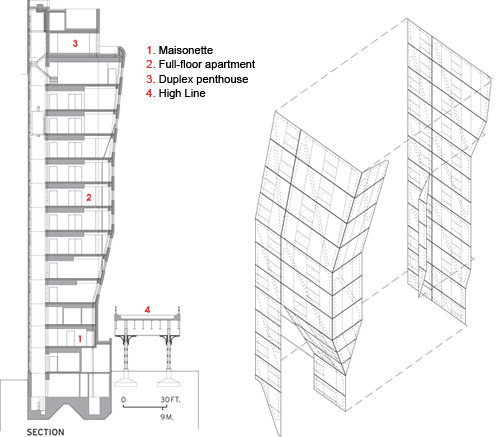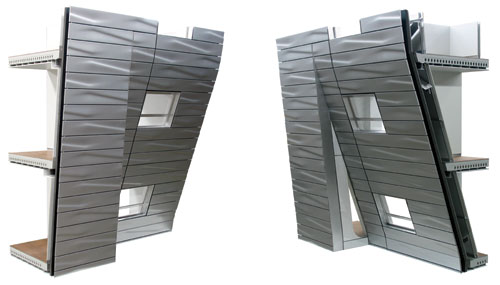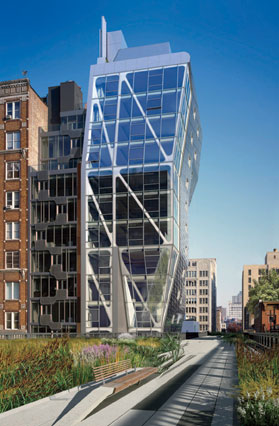Tall Buildings Push Limits by Stepping Up, Not Back
|
While the designers took into account the impact of wind loads, programmatic considerations heavily influenced the final form. By varying the infill, a mix of offices and apartments are created. Stacking more units toward the north, a taller building emerges with sunnier, south-facing terraces and views to Copenhagen. The designers wanted to minimize the impact of shadows on the surrounding low-rise houses without blocking views on the street level. By pulling away most of the pixels on the ground floor, an open outdoor plaza is created, with some space kept for lobbies and shops. Using identical pixel-unit sizes for cutouts in the ground, the plaza achieves the same qualities and character as the rest of the tower, as if the tower were emerging from the ground.
For another New York building, now under construction and moving forward, Los Angeles−based Neil M. Denari Architects used a different approach. Rather than stepping up, the reverse-tapering form of HL23-a 14-story residential building on New York City's West Side-gradually slopes out. "We didn't want a Cartesian stepping like a wedding cake," says Denari, whose design was inspired instead by a prism.
Denari, like OMA, was faced with a narrow Manhattan lot, which was further constrained by the presence of the High Line-a 22-block-long former railway that rises almost 20 feet above grade-immediately adjacent to it. But unlike OMA's tower a few blocks east, which is completely (and surprisingly) as-of-right, Denari's building- his first ground-up design-required a number of waivers. "There were a lot of restrictions for this site, but the developer was not interested in conforming to the building code," Denari admits. "He really wanted to push boundaries." Fortunately for both the architect and the developer, the city was behind the project, particularly because of its relation to the High Line, which is currently being transformed by Diller Scofidio + Renfro and Field Operations from its disused state into a nearly 7-acre, elevated urban park.

Denari's project also takes a much different structural approach than 23 East 22nd Street. "Because the building is wider at the top than at the bottom, there is a natural instability," explains Stephen DeSimone, president of DeSimone Consulting Engineers, who is working with Denari. "By using steel-which is a much lighter building material-you automatically reduce the effect of the building wanting to topple over." So, unlike 23 East 22nd Street, which can be described as a brute-force solution with its thick concrete walls, HL23 is made up of slender structural members, including canted steel columns (at a maximum 24-degree angle and located mostly along the long, steel-clad eastern facade) and diagonal bracing (composed of 8-inch pipes and forming a tripartite composition on the glazed north and south elevations).
|
The building reaches overall stability only upon completion of construction. Throughout the construction process, guy-wires provide supplemental bracing. They will stay in place until the concrete slabs are poured. Because of the small building footprint, concrete is not used in the elevator core. Instead, a steel plate acts as a sheer wall to take horizontal and twisting loads-the first time such an assembly has been used in a residential building in New York City, according to the engineers.
Â
 The structure is also integral to the envelope, and was designed at the same time, with facade consultant Front, to avoid any "reverse engineering," as Denari puts it. The sloping east facade, which cantilevers a total of 14 feet 6 inches over the High Line (it is set back 8 feet from the High Line platform at the second floor), features custom-designed stainless-steel panels with small window openings. The north and south facades feature extra-large glass panels measuring up to 111â„2 feet tall.
As construction progresses, an independent contractor lasers the structure to produce surveys on an ongoing basis. "This building is closer to a Swiss watch than most buildings," says Denari. "Ambitions are higher and tolerances are smaller. None of the steel can be even slightly out of place."
Though the forms of each of these buildings are new, the technology that makes them possible is not. And while they seem to push the limits of structural engineering, they have only just begun to scratch the surface of what's possible for 21st-century buildings.











